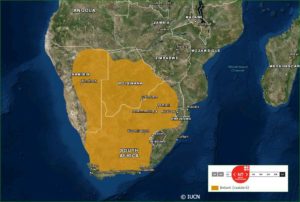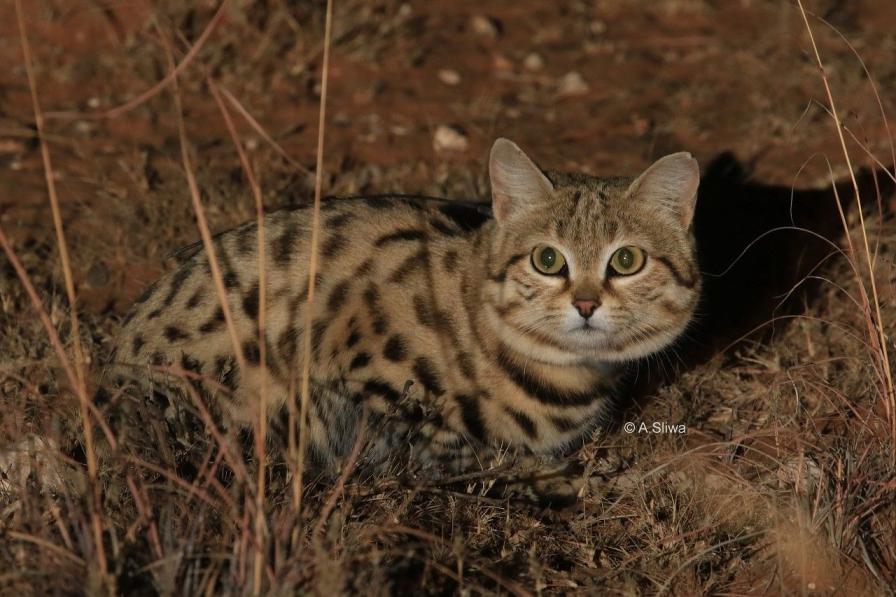- HB Length:36-52 cm (14-20″)
- Tail Length: 12-20 cm (4.7-8″)
- Height: Appr. 20 cm (8″)
- Weight: 1-2.5 kg (2.2-5.5 lbs)
- Pop. Trend: Decreasing
The Black-footed Cat Felis nigripes is Africa’s smallest felid, and among the smallest wild cat species in the world.
The soft, dense coat ranges from dark to pale tawny gold, with a bold pattern of rounded dark brown to black spots which sometimes merge into bands or rings. Their large eyes are amber or greyish brown. The chin, chest, belly and insides of the legs are whitish, and the backs of the ears are pale brown. There are two dark streaks across each cheek, and dark bars on the forelegs and haunches. The short tail, about half the body length, has two or three black rings, tapering to a black tipped point. As special adaptations to their desert habitat, these cats have a broad skull with large, rounded ears, which provide enhanced hearing in an area with scarce prey. Low-set ears are often completely flattened in an ‘aggressive’ posture, an adaptation to hunting in areas with little cover. They are protected from the hot sand by hair on the black soles of the feet.
Distribution

Black-footed Cats are found only in three countries of southern Africa: Botswana, Namibia and South Africa. They are found primarily in short to medium length grass plains, scrub desert, and sand plains, including the Kalahari and Karoo Deserts. Areas of grass with high rodent and bird densities are optimal habitat. They seem to avoid brushy country and rocky terrain, perhaps because of the occurrence of other carnivores. Average annual rainfall in the area is 100-500 mm.
The Black-footed Cat is rare compared to the other small cats of southern Africa. Knowledge of the behaviour and ecology of this cat comes from a decades-long study on the Benfontein Nature Reserve and two large farms in central South Africa. Researchers from the Black-footed Cat Working Group continue to study the cats in these three areas.
In the 60 sq km study area, they found the density of adult cats to be 0.17/sq km,, but in low-quality habitat densities were much lower. Males have larger home ranges at 20.7 sq km than females, 10 sq km. Male ranges overlap those of one to four females.
Ecology
An incredibly tenacious little cat, the natives have a legend claiming these tiny cats can bring down giraffe. While this is untrue, it pays homage to the fierce determination of these feisty little felines.
During a study in South Africa, researchers found 1725 prey items were consumed, with the males taking larger prey species. Mammals were most often taken (72%), followed by small birds, while invertebrates, amphibians and reptiles were rarely eaten. Small rodents like the large-eared mouse were particularly important during the reproductive season for females with kittens. Males showed less seasonal variation in their choice of prey, which may help to reduce competition between the sexes.
Black-footed Cats share their range with other carnivores – African wildcat, Cape foxes, bat-eared foxes and black-backed jackals. They captured smaller prey on average than African Wildcats Felis silvestris lybica, although both captured approximately the same number (12-13) of prey species per night. The cats co-exist with jackals (predators on the cats) by using burrows during the day. They share space with the Cape foxes but don’t use the same habitats, activity times or hunt the same prey species.
One small Black-footed Cat can consume 3,000 rodents each year. They have also been known to eat dead springbok lambs, although they don’t actually kill them. Larger males can take adult Cape hare which weigh approximately the same as the cat. They have also been observed eating eggs, crushing them gently between the jaws, and then licking the contents clean. Although they can get their moisture requirements from prey, they will drink water if it is available.
Black-footed Cats shelter during the heat of the day in abandoned termite mounds or burrows. Of 184 resting places in South Africa, 98% of them were abandoned springhare burrows. Their habit of resting in termite mounds has earned them the local name of ‘anthill tiger’. Their nocturnal activity varies with the length of the night, leaving and returning to the den within 30 minutes of sunset and sunrise. Hunting techniques include waiting up to 40 minutes at rodent burrows, or flushing nesting birds by walking very fast through the grass. Hunting cats are occasionally shadowed by marsh owls which swoop down on the flushed prey.
They readily climb trees and fence posts to look for bird nests, but generally there is little food in the acacia trees compared to that available on the ground. While attacking flying birds, they make frequent jumps of up to 2 metres in distance and 1.5 metres high.
Researchers observed a male Black-footed Cat steal a gerbil from a striped polecat, an equally tenacious member of the weasel family. On five occasions, researchers observed black-backed jackals circling cornered Black-footed Cats. The tiny cat attacked each time, succeeding in driving the much larger jackal away.
Reproduction
Black-footed Cats are solitary, except for females with dependent kittens, and during mating. After a 63 – 68 day gestation, one to four kittens are born at the bottom of a burrow weighing 60 – 84 grams. Females have two litters per year. The mother frequently changes dens, probably to avoid attracting predators. Their eyes open at around seven days. Kittens are independent after 3-4 months, but remain within the range of their mother for extended periods. They begin hunting at an early age, another indication of life in a harsh environment. When the mother calls an alarm, the young scatter and freeze until the danger has passed.
Conservation
The Black-footed Cat faces several man-made threats. Overgrazing by livestock is prevalent throughout its range, leading to a reduced prey base. Indiscriminate poisoning of carcasses to kill Caracals Caracal caracal and jackals affect it as the small cats readily scavenge. Poisoning of locusts which are eaten by the cats also poses a serious danger. Cats fall victim to dogs, used to chase or dig out jackals during problem animal operations.
These desert dwellers are difficult to keep in captivity outside their native range. They have very specific habitat requirements and must be kept under dry conditions. Wuppertal Zoo in Germany has had excellent breeding success however, and the core of the captive population is there.
Recommended conservation measures include more fine scale distributional studies particularly in Namibia and Botswana.
See also
Black-footed Cat Hunting & Diet
Black-footed Cat Research Findings
Range map IUCN Red List 2008
Updated 2018


André van Niekerk
I live on a game farm just outside of Upington, South Africa and I am interrested in establishing a Black footed Cat conservation centre and will like more information.
Why Is The Gyra Cat Deadly? (Could It Kill You?) - Feline Follower
[…] cats are categorized as “vulnerable”, according to ISEC. So, technically they are not endangered. But, this classification is still a concern. Meaning they […]
Pat Bumstead
It refers to head body length. They are measured from the top of their head to the base of the tail. That is the body size and the tail is always calculated separately.
Jennifer
What does HB length mean?
Wild Cats of Africa - Their Unique Characteristics - Going on Safari
[…] Black-Footed cat also known as a small-spotted cat is the smallest African cat mainly found in southwestern arid areas of South Africa. Despite its name, only the pads and underparts of the feet are black. It is a rarely seen cat as it is solitary and nocturnal as they spend most of the day sleeping in unoccupied burrows and only hunt at sunset. Unlike other cats, they are poor climbers and avoid tree branches but are good at digging and can extend their sleeping burrows to desired size and shape. […]
Adorable, Remorseless Killing Machine Is World’s Deadliest Cat | In This Day
[…] about 8 inches (20 cm) tall and weighs about 2 to 6 lbs. (1 to 3 kilograms), according to the International Society for Endangered Cats (black-footed cats are listed as “vulnerable” by the International Union for […]
Pat Bumstead
There are no black-footed cats in California, but many domestic cats have black foot pads and similar markings. Great job rescuing and caring for a feral cat!!
Paul langston
I found a farrel black footed cat in santa barbara California. It took me two months to earn its trust & now lives with me. How did this cat end up here ?. It only came into my yard because of my four kittens & the food. She wouldn’t let any body get near her or touch her for over a month but I wore her down with love food & a very beautiful gray tabby . Now she is one of us now ? Loves getting petted & loved know she can’t get enough now.
Cute, Remorseless Killing Device Is World’s Deadliest Feline | Science & Tech Blog
[…] stands about 8 inches (20 cm) high and weighs about 2 to 6 pounds. (1 to 3 kgs), according to the International Society for Endangered Cats( black-footed felines are noted as “susceptible” by the International Union for […]
Adorable, Remorseless Killing Machine Is World’s Deadliest Cat – News Online
[…] about 8 inches (20 cm) tall and weighs about 2 to 6 lbs. (1 to 3 kilograms), according to the International Society for Endangered Cats (black-footed cats are listed as “vulnerable” by the International Union for […]
Alexander Sliwa
Black-footed cats are assessed in the IUCN redlist as vulnerable, not only in 2008, but recently confirmed with sara afain for 2016. A sad reality and we need to look after them also in future.
The PERFECT Cat Diet | Spiffy Kitty Cat Nanny
[…] the Black-footed cat. This adorable killer is the smallest cat in the world. They eat whatever they can catch, from […]
» Philadelphia Zoo unveils adorable spider-eating wildcat kittens
[…] International Society for Endangered Cats says that the black-footed wildcat, or Felis nigripes, is only found in Africa. Currently, the […]
Vanessa @ Green Global Travel
Interesting read on the black-footed cat! There are so many large and exotic animals in Africa that you don’t usually hear about the smaller ones like this. I hope it does not go so far to be a threatened species.